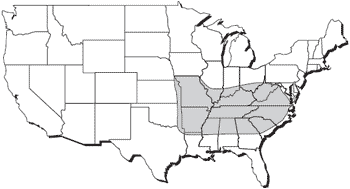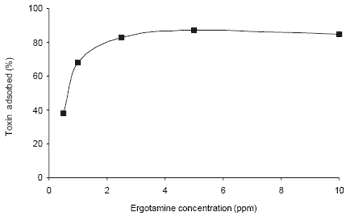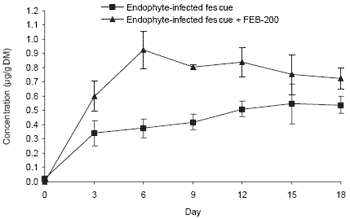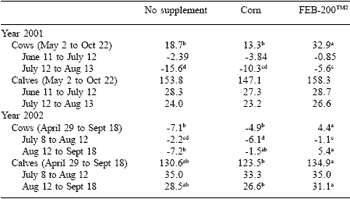Evaluation of a carbohydrate-based adsorbent for controlling intoxication associated with endophyte-infected pasture grasses
From a nutrient composition standpoint, tall fescue compares favorably with other cool season grasses, although the performance of cattle grazing on fescue is generally less than expected given the nutrient composition of the grass (Steen et al., 1979). The poor performance of animals maintained on fescue is associated with the presence of the endophyte fungus, Acremonium coenophialum, which infects tall fescue and produces alkaloid compounds that cause toxicosis (Westendorf et al., 1993). Two classes of compounds that receive the most attention as causative agents for fescue toxicosis are the pyrrolizidine alkaloids and the ergot alkaloids (Strickland et al., 1993). N-acetyl and Nformyl lolines (Figure 2) account for the majority of the pyrrolizidine alkaloid content in endophyteinfected tall fescue (Yates et al., 1990). The clavine alkaloids, lysergic acid amides and ergopeptines all belong to the broader group of ergot alkaloids.
Several ergopeptines have been identified in endophyte-infected tall fescue, including ergocornine, ergocryptine, ergocrystine, ergonine, ergosine, ergotamine and ergovaline (Yates et al., 1985; Yates and Powell, 1988). Ergovaline is the primary ergopeptine alkaloid (Figure 2), accounting for 84-97% of total ergopeptine alkaloid content associated with fescue toxicosis (Porter, 1995), although N-acetyl and N-formyl lolines may also contribute to the disorder (Bush et al., 1993; Yates et al., 1990).
Symbiotic association between the endophyte fungus and the tall fescue plant The endophyte fungus forms a mutualistic relationship with the fescue plant in such a way that endophyte derives its nourishment and means of reproduction from the fescue plant, and the fescue plant benefits from enhanced tolerance to biotic and abiotic environmental stresses (Siegel et al., 1985; Bacon, 1993; Joost, 1995; Humphry et al., 2002). As a result, fescue plants infected with endophyte fungus are more resistant to heavy animal traffic, more resistant to insects and nematodes, and better able to tolerate drought than fescue plants free of endophyte fungus. Such characteristics give infected fescue plants a competitive advantage in the normal pasture setting and have allowed the endophyte-infected grasses to become the predominant vegetation in many pastures.
Effects of endophyte fungus on animals
Animals maintained on fescue grass containing the endophyte fungus have shown some or all of the following symptoms of endophyte toxicosis:
1) lower feed intake;
2) lower weight gain;
3) lower milk production;
4) reduced reproductive performance;
5) higher rectal temperature;
6) higher respiration rate;
7) rough hair coat;
8) more time spent in shade;
9) excessive salivation;
10) reduced serum prolactin level; and
11) nervousness (Stuedemann and Hoveland, 1988; Schmidt and Osborn, 1993).
Although, all of these responses are important, depressed weight gain, milk production and conception rates are of particular economic significance in cattle production systems. Hoveland (1993) estimated that the US beef industry alone loses more than $609 million annually because of slow weight gains and reproductive inefficiency of cattle grazing endophyte-infected fescue. Increased internal body temperatures of cows grazing endophyte-infected fescue contribute to vasoconstriction (Oliver et al., 1993) and subsequent reduced blood flow to peripheral tissues (Browning and Leite-Browning, 1997; Osborn et al., 1992). Reduced peripheral blood flow during warm summer months could contribute to hyperthermia through reduced body heat dissipation from skin. Animals that have increased body temperatures spend more time in shade and less time grazing, which will result in decreased dry matter intake and performance.
Figure 1. Region of the US dominated by tall fescue.
Figure 2. Some of the toxins involved in fescue toxicosis.
Counteraction of fescue toxicosis
Because the presence of endophyte fungus in the fescue plant provides many agronomic benefits, researchers have been investigating strategies for alleviating some or all of the toxic effects of endophyte fungus. Supplementation of easily digested energy sources (Hannah et al., 1989; Forcherio et al., 1993), protein (Forcherio et al., 1993), mineral and/or vitamin (Paterson et al., 1995), Aspergillus oryzae fermentation extract (Humphry et al., 2002), and hydrated sodiumcalcium aluminosilicate (Chestnut et al., 1992) have all been attempted in strategies to counteract fescue toxicosis. However these methods have had only limited success.
Another approach that has been shown to counteract fescue toxicosis involves a supplementation strategy that uses yeast-derived glucomannan fraction (FEB-200TM; Alltech Inc., Nicholasville, KY) to adsorb toxins in the gastrointestinal tract. The glucomannan is derived from the inner cell wall of a selected strain of Saccharomyces cerevisiae.
To demonstrate the potential for decreasing the bioavailability of fescue toxins, modified yeast cell wall preparations were screened for their ability to adsorb ergotamine. Ergotamine is a readily available compound that is structurally similar to ergovaline, the major ergopeptine alkaloid associated with endophyte infestation of tall fescue (Lyons et al., 1986).
An in vitro study demonstrated that modified glucomannan could adsorb ergotamine in a concentration-dependent fashion. Addition of this yeast cell wall fraction at a constant concentration with increasing ergotamine concentrations demonstrated that the maximum adsorption equilibrium was reached at ergotamine concentrations above 2 ppm (Figure 3). These studies demonstrated a high affinity for the toxin in an aqueous solution and suggested the potential for using the yeast cell wall material to prevent toxin absorption in vivo. Based on these findings, The University of Kentucky and Alltech Inc. have conducted a series of studies to evaluate the effects of supplementation of FEB-200TM on the symptoms of fescue toxicosis and performance of cow/calf pairs maintained on endophyte-infected tall fescue.
Figure 3. In vitro adsorption kinetics of ergotamine with FEB-200TM (1 mg/ml) in water.
Effects of FEB-200TM on excretion of toxins and symptoms of fescue toxicosis
METHODS
Two trials were conducted to evaluate the effects of FEB-200TM on excretion of toxins and symptoms of fescue toxicosis. Twelve Holstein steers were acclimatized to an environmentally-controlled room for 7 days by gradually raising the room temperature to 30°C. Steers were maintained in individual tie stalls under 16 hrs of daylight and 8 hrs of darkness and had continual access to fresh water. A complete diet consisting of cracked corn, cottonseed hulls, crimped oats, soybean meal and a mineral/vitamin mix was fed during the adjustment period. Following this period, steers were weighed, blocked by weight and assigned to one of four treatments:
1) Endophyte-infected fescue seed.
2) Endophyte-infected fescue seed plus FEB- 200TM.
3) Endophyte-free fescue seed.
4) Endophyte-free fescue seed plus FEB-200TM.
Fescue seed was used because it is in this part of the plant that the endophyte (and its toxins) is concentrated. The diet consisted of cracked corn grain, cottonseed hulls, crimped oat grain, fescue seed, soybean meal, and vitamin and mineral supplementation. Fescue seed was included at a concentration of 21.6% in the first trial and 12.1% in the second trial. FEB-200TM was added at 2 kg/ tonne in both trials.
RESULTS
In the first trial, greater amounts of ergovaline and ergovalinine were excreted in the feces of animals receiving the FEB-200TM supplement (Figure 4). This was consistent with the hypothesis that the toxins were adsorbed to the yeast preparation and were less bioavailable. Although FEB-200TM increased excretion of ergovaline and ergovalinine, inclusion of higher levels of fescue seed (21.6%) in the diet still allowed for considerable toxin absorption. As a result, dry matter intake and rectal temperatures remained depressed due to extremely high levels of ergovaline and ergovalinine (0.95 and 0.98 ppm, respectively).
Figure 4. Means of fecal total ergot alkaloids (ergovaline and ergovalinine) concentration of steers fed endophyte-infected fescue seed with or without FEB-200TM (Trial 1).
In Trial 2, ergovaline and ergovalinine content of diets to which fescue seed was added were 0.490 and 0.399 ppm, respectively. Dry matter intake was decreased and rectal temperatures increased in response to these toxin levels relative to values for animals given diets containing endophyte-free fescue seed (Table 1). Supplementation of the endophyte-infected diet with FEB-200TM increased dry matter intake and decreased rectal temperatures. This indicated that in the first trial the amount of ergovaline and ergovalinine in the diet exceeded adsorption capacity of FEB-200TM.
It was also found that FEB-200TM increased dry matter intake in steers fed the diet containing endophyte-free fescue seed. One explanation for the increased dry matter intake is that steers fed FEB-200TM overcame heat stress and therefore ate more feed. Another explanation could be the presence of another toxin in endophyte-free fescue seed that could be adsorbed by FEB-200TM.
Westerndorf et al. (1993) reported that three classes of compounds present in tall fescue are the diazaphenanthrene alkaloids, the ergot alkaloids, and the pyrrolizidine alkaloids, all of which are suspected toxins. The diazaphenanthrene alkaloids are associated with both endophyte-free and endophyteinfected tall fescue, while the ergot alkaloids and pyrrolizidine alkaloids are associated only with endophyte-infected tall fescue.
Effects of FEB-200TM on internal body temperatures of cows grazing endophyteinfected tall fescue pasture
METHODS
Twenty-seven Angus and Angus x Beefmaster cows were randomly assigned to nine paddocks containing endophyte-infected tall fescue in a study to evaluate the potential of FEB-200TM to alleviate the internal body temperature effect associated with endophyte toxicosis in grazing animals during the warm summer months. Three replicate pastures were randomly assigned to each of three treatments. Treatments were: 1) Negative control (no supplement) 2) Positive control (0.450 kg/head/day shelled ground corn); and, 3) FEB-200TM (0.450 kg/ head/day mixture of shelled ground corn (95.6%) and FEB-200TM (4.4%). Supplements were fed once a day at approximately 0800 hrs.
Tympanic temperatures were continuously monitored at 30-min intervals during 3-day periods in mid-June, July and August of each year. A thermistor probe was inserted into the ear canal within 2 cm of the tympanic membrane and connected to a data logger, which was secured on a halter. The ear was wrapped to form a tube shape and then synthetic foam was inserted into the ear canal to secure the thermistor probe (Paul, 1999). Each cow’s daily maximum, minimum and average tympanic temperature were recorded for each 3- day period. Daily diurnal ranges and daily differences between maximum and average tympanic temperatures (partial differences) were calculated. Ambient temperatures were also downloaded from a weather station located 9.6 km from the pastures.
RESULTS
Average maximum and minimum ambient temperatures were 30.6 and 19.2; 30.5 and 19.7; and 28.1 and 16.1 °C for the June, July, and August periods, respectively. The temperatures in the early fall tended to be much lower than normal and did not result in the usual temperature stress associated with this time of year in the region. However, cows supplemented with FEB-200TM had lower maximum tympanic temperatures than cattle in the other treatment groups in July and August (Table 2).
Average maximum tympanic temperatures were the lowest for cattle given FEB-200TM and highest for those given no supplement. Minimum and daily average tympanic temperatures were numerically, but not statistically, lower for cows given FEB-200TM in all months. Average minimum and daily average tympanic temperatures were lower (P<0.05) for cattle given FEB-200TM compared to negative controls. Diurnal changes in tympanic temperatures were lower (P<0.05) than on other treatments for cows given FEB-200TM in July, and lower than cattle in the negative control group in June and August.
Average diurnal tympanic temperature changes were the lowest for the FEB-200TM treatment group and highest for negative controls. Lower diurnal changes indicate that internal body temperatures of cows given FEB-200TM were very constant during both the day and night. However, cows not given the supplement had high internal body temperatures during daytime, but were able to dissipate heat at night. Cattle that have internal body temperature in the comfort zone should spend less time in shade and more time grazing, which may result in increased animal performance.
Table 1. Least square means for dry matter intake and rectal temperatures of steers fed endophyte-infected or endophyte-free fescue seed with or without FEB-200TM (Trial 2).
a,b,cMeans within a row with different superscripts differ (P<.05).
Table 2. Least square means of tympanic temperatures (°C)of cows maintained on endophyte-infected fescue pastures.
1Each treatment mean based on 3 replicate pastures.
220 g/head/day
3Maximum minus minimum temperature.
a,b,cMeans differ (P<0.05).
d,eMeans differ (P<0.10).
Effects of FEB-200TM on body weight gain of cows and calves grazing endophyteinfected tall fescue
METHODS
During 2001 and 2002, 92 Angus and Angus x Beefmaster cow/calf pairs were randomly assigned to nine endophyte-infected tall fescue paddocks (10.5 ha) to evaluate the ability of FEB-200TM to prevent the negative effects of endophyte toxins on animal weight gain. Three replicate pastures were randomly assigned to one of three treatments.
Treatments were: 1) Negative control (no supplement) 2) Positive control (0.450 kg/head/day shelled ground corn); and, 3) FEB-200TM (0.450 kg/ head/day mixture of shelled ground corn (95.6%) and FEB-200TM (4.4%). Supplements were fed to cows once a day at approximately 0800 hrs. It should be noted that while calves were not prevented from gaining access to feed given the cows, the supplements were only offered to the cows. Cows and calves were weighed two consecutive days at the beginning and at the end of the trial, and every 35 days throughout the 2-year trial.
RESULTS
In 2001 (Table 3), cows given FEB-200TM gained 76% more body weight than negative controls and 147% more body weight than those receiving the corn supplement without FEB-200TM. Calves given FEB-200TM had numerically higher body weight gains than those in the other two treatment groups, however it was not statistically significant. Average maximum and minimum ambient temperatures during 2001 were 30.6 and 19.2; 30.5 and 19.7; and 28.1 and 16.1 °C for the June, July, and August periods, respectively. June and July were the hottest months of summer. During these months cows given FEB-200TM tended to lose less body weight than those in the unsupplemented treatment groups. During these hottest months, calves given FEB- 200TM had numerically higher body weight gains than those on other treatments.
In 2002 (Table 3), unsupplemented cows lost body weight, while cows given FEB-200TM gained body weight, and these differences were statistically significant (-7.1, -4.9 and 4.4 kg, respectively). Supplementation of FEB-200TM to cows increased calf body weight gain compared to when cows were given corn alone (134.9 vs 123.5 kg), however gains did not differ from those with dams given no supplement. Average maximum and minimum ambient temperatures during 2002 were 29.3 and 15.1; 31.4 and 19.5; and 32.7 and 25.3°C for the June, July, and August periods, respectively. July and August were the hottest months of summer. Cows given FEB-200TM tended to have higher body weight gain compared to those in the unsupplemented treatment groups during the hottest months. Also, calves with dams given FEB-200TM had higher body weights than those given corn only from August to September, which can be expected to lead to higher weaning weights.
Table 3. Least square means for body weight gain (kg) of cows and calves maintained on endophyte-infected fescue pastures1.
1Each treatment mean based on 3 replicate pastures.
220 g/head/day
a,b,Means within a row with different superscripts differs (P<0.05).
c,dMeans within a row with different superscripts differs (P<0.10).
Results from all the studies with steers, cows and cow/calf pairs indicate that FEB-200TM was able to adsorb ergovaline and ergovalinine from endophyteinfected tall fescue in the gastrointestinal tract of cattle before these toxins were absorbed into the bloodstream and could exert toxic effects.
Conclusions
Endophyte-infected tall fescue is the primary coolseason grass in the southeastern US, providing the major source of forage for the beef cattle and equine industries in this region. Even though animal performance is impaired due to the presence of endophyte fungus in tall fescue, the endophyte provides indisputable agronomic advantages.
Because of this, researchers and producers will continue to seek ways to reduce the impact of fescue toxicosis. Studies reported here have shown that supplementation of FEB-200TM to cattle grazing on endophyte-infected tall fescue alleviated some of the negative effects of endophyte toxins on animal performance.
References
Bacon, C.W. 1993. Abiotic stress tolerance (moisture, nutrients) and photosynthesis in endophyte-infected tall fescue. Agric. Ecosyst. & Environ. 44:123-141.
Browning, R., Jr. and M.L. Leite-Browning. 1997. Effect of ergotamine and ergonovine on thermal regulation and cardiovascular function in cattle. J. Anim. Sci. 75:176-181.
Bush, L.P., F.F. Fannin, M.R. Siegel, D.L. Dahlman and H. R. Burton. 1993. Chemistry, occurrence and biological effects of saturated pyrrolizidine alkaloids associated with endophyte-grass interactions. Agric. Ecosyt. & Environ. 44:81-102.
Chestnut, A.B., P.D. Anderson, M.A. Cochran, H.A. Fribourg and K.D. Gwinn. 1992. Effects of hydrated sodium calcium aluminosilicate on fescue toxicosis and mineral absorption. J. Anim. Sci. 70:2838-2846.
Forcherio, J.C., J.A. Paterson and M.S. Kerley. 1993. Effects of supplemental energy or protein on rumen parameters and performance of first and second partum beef cows grazing tall fescue. J. Anim. Sci. 71(Suppl. 1):197 (Abstr.).
Hannah, S.M., M.T. Rhodes, J.A. Paterson, M.S. Kerley, J.E. Williams and K.E. Turner. 1989. Influence of energy supplementation on forage intake, digestibility and grazing time by cattle grazing tall fescue. Nutr. Rep. Int. 40:1153.
Hoveland, C.S. 1993. Economic importance of Acremonium endophytes. Agric. Ecosyst. and Environ. 44:3-12.
Humphry, J.B., K.P. Coffey, J.L. Moyer, F.K. Brazle and L.W. Lomas. 2002. Intake, digestion, and digestive characteristics of Neotyphodium coenophialum-infected and uninfected fescue by heifers offered hay diets supplemented with Aspergillus oryzae fermentation extract or laidlomycin propionate. J. Anim. Sci. 80:225-234.
Joost, R.E. 1995. Acremonium in fescue and ryegrass: Boon or bane? A review. J. Anim. Sci. 73:881-888.
Lyons, P.C., R.D. Plattner and C.W. Bacon. 1986. Occurrence of peptide and clavine ergot alkaloids in tall fescue grass. Science 232:487-489.
Oliver, J.W., L.K. Abney, J.R. Strickland and R.D. Linnabary. 1993. Vasoconstriction in bovine vasculature induced by the tall fescue alkaloid lysergamide. J. Anim. Sci. 71:2708-2813.
Osborn, T.G., S.P. Schmidt, D.N. Marple, C.H. Rahe and J.R. Steenstra. 1992. Effects of consuming fungus-infected and fungus-free tall fescue and ergotamine tartrate on selected physiological variables of cattle in environmentally controlled conditions. J. Anim. Sci. 70:2501-2509.
Paterson, J., C. Forcherio, B. Larson, M. Samford and M. Kerley. 1995. The effects of fescue toxicosis on beef cattle productivity. J. Anim. Sci. 73:889-898.
Paul, R.M.. 1999. The effects of artificial shade on tympanic temperature and production characteristics of grazing beef cattle. Ph.D. Dissertation, University of Kentucky, Lexington, KY.
Porter, R.K. 1995. Analysis of endophyte toxins: Fescue and other grasses toxic to livestock. J. Anim. Sci. 73:871-880.
Schmidt, S.P. and T.G. Osborn. 1993. Effects of endophyte-infected tall fescue on animal performance. In: Acremonium/Grass Interactions (R. Joost and S. Quisenberry, eds), Elsevier Science Publishers, Amsterdam, The Netherlands, pp. 233-262.
Siegel, M.R., G.C. M. Latch and M.C. Johnson. 1985. Acromonium fungal endophytes of tall fescue and perennial ryegrass: significance and control. Plant Dis. 69:179-183.
Steen, W.W., N. Gay, J.A. Boling, R.C. Buckner, L.P. Bush and G. Lacefield. 1979. Evaluation of Kentucky31, GI-306, GI-307 and Kenby tall fescue as pasture for yearling steers. II. Growth, physiological response, and plasma constituents of yearling steers. J. Anim. Sci. 48:618-623.
Strickland, J.R., J.W. Oliver and D.L. Cross. 1993. Fescue toxicosis and its impact on animal agriculture. Vet. Human Toxicol. 35:454-464.
Stuedemann, J.R. and C.S. Hoveland. 1988. Fescue endophyte: History and impact on animal agriculture. J. Prod. Agric. 1:39-44.
Westendorf, M.L., G.E. Mitchell, Jr., R.E. Tucker, L.P. Bush, R.J. Petroski and R.G. Powell. 1993. In vitro and in vivo ruminal and physiological responses to endophyte-infected tall fescue. J. Dairy Sci. 76:555-563.
Yates, S.G. and R.G. Powell. 1988. Analysis of ergopeptine alkaloids in endophyte-infected tall fescue. J. Agric. Food Chem. 36:337-340.
Yates, S.G., R.D. Plattner and G.B. Garner. 1985. Detection of ergopeptine alkaloids in endophyteinfected, toxic KY-31 tall fescue by mass spectrometry/mass spectrometry. J. Agric. Food Chem. 33:719-722.
Yates, S.G., R.J. Petroski and R.B. Powell. 1990. Analysis of loline alkaloids in endophyte-infected tall fescue by capillary gas chromatography. J. Agric. Food Chem. 38:182-185.
Authors: V. AKAY1, K.A. DAWSON1, D.G. ELY2 and D.K. AARON2
1 North American Biosciences Center, Alltech Inc., Nicholasville, Kentucky, USA
2 University of Kentucky, Lexington, Kentukcy, USA




